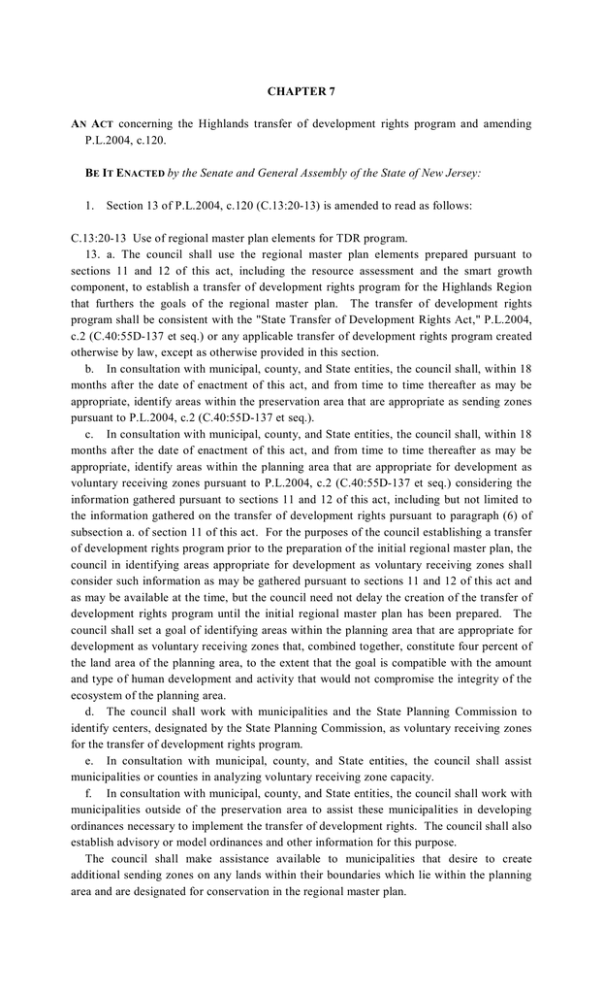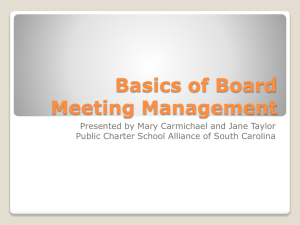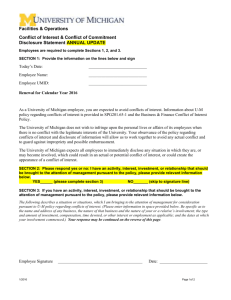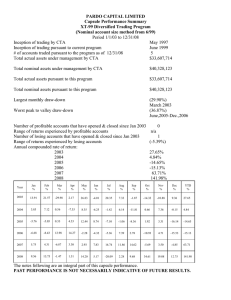concerning the Highlands transfer of development rights program and amending
advertisement

CHAPTER 7 AN ACT concerning the Highlands transfer of development rights program and amending P.L.2004, c.120. BE IT ENACTED by the Senate and General Assembly of the State of New Jersey: 1. Section 13 of P.L.2004, c.120 (C.13:20-13) is amended to read as follows: C.13:20-13 Use of regional master plan elements for TDR program. 13. a. The council shall use the regional master plan elements prepared pursuant to sections 11 and 12 of this act, including the resource assessment and the smart growth component, to establish a transfer of development rights program for the Highlands Region that furthers the goals of the regional master plan. The transfer of development rights program shall be consistent with the "State Transfer of Development Rights Act," P.L.2004, c.2 (C.40:55D-137 et seq.) or any applicable transfer of development rights program created otherwise by law, except as otherwise provided in this section. b. In consultation with municipal, county, and State entities, the council shall, within 18 months after the date of enactment of this act, and from time to time thereafter as may be appropriate, identify areas within the preservation area that are appropriate as sending zones pursuant to P.L.2004, c.2 (C.40:55D-137 et seq.). c. In consultation with municipal, county, and State entities, the council shall, within 18 months after the date of enactment of this act, and from time to time thereafter as may be appropriate, identify areas within the planning area that are appropriate for development as voluntary receiving zones pursuant to P.L.2004, c.2 (C.40:55D-137 et seq.) considering the information gathered pursuant to sections 11 and 12 of this act, including but not limited to the information gathered on the transfer of development rights pursuant to paragraph (6) of subsection a. of section 11 of this act. For the purposes of the council establishing a transfer of development rights program prior to the preparation of the initial regional master plan, the council in identifying areas appropriate for development as voluntary receiving zones shall consider such information as may be gathered pursuant to sections 11 and 12 of this act and as may be available at the time, but the council need not delay the creation of the transfer of development rights program until the initial regional master plan has been prepared. The council shall set a goal of identifying areas within the planning area that are appropriate for development as voluntary receiving zones that, combined together, constitute four percent of the land area of the planning area, to the extent that the goal is compatible with the amount and type of human development and activity that would not compromise the integrity of the ecosystem of the planning area. d. The council shall work with municipalities and the State Planning Commission to identify centers, designated by the State Planning Commission, as voluntary receiving zones for the transfer of development rights program. e. In consultation with municipal, county, and State entities, the council shall assist municipalities or counties in analyzing voluntary receiving zone capacity. f. In consultation with municipal, county, and State entities, the council shall work with municipalities outside of the preservation area to assist these municipalities in developing ordinances necessary to implement the transfer of development rights. The council shall also establish advisory or model ordinances and other information for this purpose. The council shall make assistance available to municipalities that desire to create additional sending zones on any lands within their boundaries which lie within the planning area and are designated for conservation in the regional master plan. P.L.2010, CHAPTER 7 2 g. Notwithstanding the provisions of P.L.2004, c.2 (C.40:55D-137 et seq.) to the contrary, the council shall perform the real estate analysis for the Highlands Region that is required to be performed by a municipality prior to the adoption or amendment of any development transfer ordinance pursuant to P.L.2004, c.2. h. (1) The council shall set the initial value of a development right. The Office of Green Acres in the Department of Environmental Protection and the State Agriculture Development Committee shall provide support and technical assistance to the council in the operation of the transfer of development rights program. The council shall establish the initial value of a development right considering the Department of Environmental Protection rules and regulations in effect the day before the date of enactment of this act. (2) The council shall give priority consideration for inclusion in a transfer of development rights program any lands that comprise a major Highlands development that would have qualified for an exemption pursuant to paragraph (3) of subsection a. of section 30 of this act but for the lack of a necessary State permit as specified in subparagraph (b) or (c), as appropriate, of paragraph (3) of subsection a. of section 30 of this act, and for which an application for such a permit had been submitted to the Department of Environmental Protection and deemed by the department to be complete for review on or before March 29, 2004. i. (1) The council may use the State Transfer of Development Rights Bank established pursuant to section 3 of P.L.1993, c.339 (C.4:1C-51) for the purposes of facilitating the transfer of development potential in accordance with this section and the regional master plan. The council may also establish a development transfer bank for such purposes. (2) At the request of the council, the Department of Banking and Insurance, the State Transfer of Development Right Bank, the State Agriculture Development Committee, and the Pinelands Development Credit Bank shall provide technical assistance to the council in establishing and operating a development transfer bank as authorized pursuant to paragraph (1) of this subsection. (3) Any bank established by the council shall operate in accordance with provisions of general law authorizing the creation of development transfer banks by municipalities and counties. j. The Office of Smart Growth shall review and coordinate State infrastructure capital investment, community development and financial assistance in the planning area in furtherance of the regional master plan. Prior to the council establishing its transfer of development rights program, the Office of Smart Growth shall establish a transfer of development rights pilot program that includes Highlands Region municipalities. k. Any municipality in the planning area whose municipal master plan and development regulations have been approved by the council to be in conformance with the regional master plan in accordance with section 14 or 15 of this act, and that amends its development regulations to accommodate voluntary receiving zones within its boundaries which are identified pursuant to subsection c. of this section and which provide for a minimum residential density of five dwelling units per acre, shall, for those receiving zones, be: eligible for an enhanced planning grant from the council of up to $250,000; eligible for a grant to reimburse the reasonable costs of amending the municipal development regulations; authorized to impose impact fees in accordance with subsection m. of this section; entitled to legal representation pursuant to section 22 of this act; accorded priority status in the Highlands Region for any State capital or infrastructure programs; and eligible for any other appropriate assistance, incentives, or benefits provided pursuant to section 18 of this act. P.L.2010, CHAPTER 7 3 l. Any municipality located outside of the Highlands Region that (1) has received plan endorsement by the State Planning Commission pursuant to the "State Planning Act," P.L.1985, c.398 (C.52:18A-196 et al.), or the State Planning Commission, in coordination with the Highlands Water Protection and Planning Council, determines has designated an appropriate project area as a receiving zone, (2) establishes a receiving zone which provides for a minimum residential density of five dwelling units per acre for the transfer of development rights from a sending zone in the Highlands Region, and (3) accepts that transfer of development rights, shall, for those receiving zones, be eligible for the same grants, authority, and other assistance, incentives, and benefits as provided to municipalities in the planning area pursuant to subsection k. of this section except for legal representation as provided pursuant to section 22 of this act and priority status in the Highlands Region for any State capital or infrastructure programs. m. (1) A municipality that is authorized to impose impact fees under subsection k. of this section shall exercise that authority by ordinance. (2) Any impact fee ordinance adopted pursuant to this subsection shall include detailed standards and guidelines regarding: (a) the definition of a service unit, including specific measures of consumption, use, generation or discharge attributable to particular land uses, densities and characteristics of development; and (b) the specific purposes for which the impact fee revenues may be expended. (3) An impact fee ordinance shall also include a delineation of service areas for each capital improvement whose upgrading or expansion is to be funded out of impact fee revenues, a fee schedule which clearly sets forth the amount of the fee to be charged for each service unit, and a payment schedule. (4) An impact fee may be imposed by a municipality pursuant to this subsection in order to generate revenue for funding or recouping the costs of new capital improvements or facility expansions necessitated by new development, to be paid by the developer as defined pursuant to section 3.1 of P.L.1975, c.291 (C.40:55D-4). Improvements and expansions for which an impact fee is to be imposed shall bear a reasonable relationship to needs created by the new development, but in no case shall an impact fee assessed pursuant to this subsection exceed $15,000 per dwelling unit unless and until impact fees are otherwise established by law at which time the impact fee shall be 200% of the calculated impact fee. (5) No impact fee shall be assessed pursuant to this subsection against any low or moderate income housing unit within an inclusionary development as defined under P.L.1985, c.222 (C.52:27D-301 et al.). No impact fee authorized under this subsection shall include a contribution for any transportation improvement necessitated by a new development in a county which is covered by a transportation development district created pursuant to the "New Jersey Transportation Development District Act of 1989," P.L.1989, c.100 (C.27:1C-1 et al.). 2. This act shall take effect immediately. Approved May 5, 2010.




